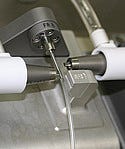Catheter Cutter Removes Chads and Burrs
April 12, 2010
|
Rainbow Medical's catheter cutter features a vacuum system to remove chads. |
Before 2000, most people had never heard of chads--those pesky little pieces of paper that cling stubbornly to ballots. But hanging chads are not merely a problem for elections; they can also imperil patient safety if they remain on catheters. Having declared war on chads, Rainbow Medical Engineering Ltd. has developed an ultrasonic catheter-cutting machine for preventing chads. At the same time, the system produces burr-free edges on the apertures of catheters that are measurably smoother than those produced by conventional systems, according to the company. As a result of Rainbow's endeavors, the system was crowned the Best Technology Application at the 2009 Plastics Industry Awards in London.
In standard catheter-cutting operations, the chad may not completely detach from the tube, or it may detach but remain lodged within the catheter. If not detected during the manufacturing process, this waste material can migrate into the patient. To remedy this problem, the new technology uses a vacuum to collect chads, which are passed through an electronic counter. If an anomaly is detected, processing is halted automatically. The production cycle cannot be resumed until the faulty catheter has been inserted into a disposal unit.
"Until now, chads were either left partially attached to the edge of the catheter or pressed into the hole," remarks Alan Profit, Rainbow's founder and owner. Unless the error was detected through visual inspection, the chad could still be present when the catheter was inserted into the patient.
"A leading medical company was interested in finding a solution to problems caused by urinary catheters," Profit explains. "The process of cutting the eyes, or holes, in urinary catheters is mechanical pressure, which produces eyes with surfaces or edges that are not entirely smooth. The upper surface of the eye can cause tissue damage to the urinary tract when the catheter is inserted or removed, which can lead to infection."
The use of ultrasonic cutting produces a burr-free tube with what is known as end rounding. "This is vitally important," Profit notes, "since it dramatically reduces trauma during insertion and withdrawal, while also reducing somewhat the particulate or bacterial incrustation that can attack the lower surface of the eye." The catheter-cutting system also entails some cost advantages, according to Profit. "The system's ultrasonic, vacuum extraction, and optical sensing capabilities eliminate the need for customers to either visually inspect each item or use small pin gauges to check for debris--routines that require 100% inspection."
Rainbow Medical Engineering Ltd
Letchworth Garden City, UK
www.rainbow-medical.eu
You May Also Like


.png?width=300&auto=webp&quality=80&disable=upscale)